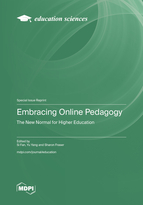Embracing Online Pedagogy: The New Normal for Higher Education
A special issue of Education Sciences (ISSN 2227-7102). This special issue belongs to the section "Technology Enhanced Education".
Deadline for manuscript submissions: closed (31 December 2022) | Viewed by 30479
Special Issue Editors
Interests: higher education and online pedagogy; learning analytics; teacher education; early childhood education and language education
Interests: graph representation learning; spatiotemporal data analysis; urban computing; learning analytics
Special Issues, Collections and Topics in MDPI journals
Special Issue Information
Dear Colleagues,
Since February 2020, the outbreak of the COVID-19 pandemic has thrust learning and teaching into the online space. These challenges have triggered creative solutions. Innovative pedagogical approaches are being used to minimize disruptions in the absence of face-to-face contact. Courses are delivered through online and alternative means, even in universities with the most traditional mode of delivery. Many Western countries, including Australia, have further developed their courses through existing learning management systems. In some Asian countries, we have seen the adoption of diverse online delivery tools, such as Zoom and Tencent Classroom, and other alternative solutions in rural and regional areas that require fewer technological or financial resources. Online learning and teaching have become the “new normal”, and there has been a continuation of online and blended courses, even post-COVID-19 lockdowns. In a sense, the pandemic has set a milestone in the evolution of higher education.
This Special Issue has been developed to capture this changing moment. The Special Issue is centered around innovative pedagogical approaches, especially those that emerged to promote student agency and learner autonomy. It can involve learning and teaching in multiple disciplines, including, but not limited to, teacher education, health sciences, learning analytics, and language education. It can include topics such as pedagogical innovations, student agency, engagement and retention, curriculum reform, policy development, and the teaching and research nexus. We welcome manuscripts that report findings of empirical research, or critical reflections on innovative pedagogical advancement. We also welcome contributions that have adopted diverse methodological perspectives, including qualitative, quantitative, data-driven, and mixes-methods, as well as systematic reviews of publications capturing changes during the COVID-19 period or forecasting trends post-COVID-19.
In particular, this Special Issue encourages submissions on the following topics: (1) innovative pedagogical approaches to provide creative solutions to issues that have arisen during the COVID-19 pandemic; (2) research striving to understand how online learning can help promote student agency and learner autonomy; (3) learning analytics research on behavioral pattern mining and student attrition prediction; (4) evidence-based pedagogical practices to promote student engagement and retention. It is hoped that this Special Issue will provide a platform for university lecturers to showcase innovative pedagogical approaches during this rapidly changing time, and for researchers to share recent research findings related to online learning and teaching in higher education. It will seek to inform course developers and higher education institutions in future decision and policy making, and ultimately lead to better student support, experiences, and outcomes in future online and blended courses.
Dr. Si Fan
Dr. Yu Yang
Prof. Dr. Sharon Fraser
Guest Editors
Manuscript Submission Information
Manuscripts should be submitted online at www.mdpi.com by registering and logging in to this website. Once you are registered, click here to go to the submission form. Manuscripts can be submitted until the deadline. All submissions that pass pre-check are peer-reviewed. Accepted papers will be published continuously in the journal (as soon as accepted) and will be listed together on the special issue website. Research articles, review articles as well as short communications are invited. For planned papers, a title and short abstract (about 100 words) can be sent to the Editorial Office for announcement on this website.
Submitted manuscripts should not have been published previously, nor be under consideration for publication elsewhere (except conference proceedings papers). All manuscripts are thoroughly refereed through a double-blind peer-review process. A guide for authors and other relevant information for submission of manuscripts is available on the Instructions for Authors page. Education Sciences is an international peer-reviewed open access monthly journal published by MDPI.
Please visit the Instructions for Authors page before submitting a manuscript. The Article Processing Charge (APC) for publication in this open access journal is 1800 CHF (Swiss Francs). Submitted papers should be well formatted and use good English. Authors may use MDPI's English editing service prior to publication or during author revisions.
Keywords
- higher education
- online learning and teaching
- blended learning
- online pedagogy
- computer supported learning
- learning analytics








